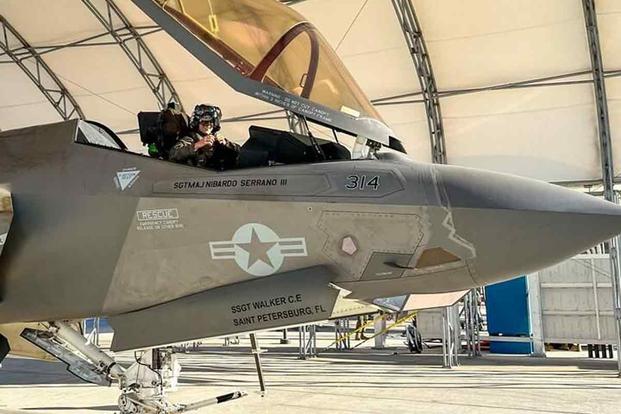After Maj. Zachary Sessa launched his F-35C Lightning II’s payload at Houthi weapons storage facilities in Yemen last year, the historical significance of the flight dawned on him.
Nearly a year ago, Sessa deployed with the Marine Corps’ first F-35C unit aboard the USS Abraham Lincoln bound for the Pacific. But with less than a month out of port, the Pentagon ordered the carrier strike group to the Middle East as Iran-backed Houthis continued to attack shipping vessels in the region.
The physical redirection also constituted a mental one for the troops aboard the strike group. Having spent their pre-deployment expecting to train in the Pacific amid escalating tensions with China in the region, air-to-surface combat near contested Middle Eastern waterways quickly settled in as the new reality as they steamed westward.
Read Next: Tricare West Region Patients Get Another Extension on Specialty Care Authorizations
By early November, just four months after the group left the West Coast, Sessa was in the air leading the first combat missions the Marine Corps’ stealth fighter had ever participated in — missions that would lead to top aviation awards for him and his squadron.
Sessa, 33, of Butler, Pennsylvania, comes from a long line of aviators, with his father having flown the A-7D Corsair for the Air National Guard and his grandfather, a Marine veteran, flew commercial aircraft.
He reflected on the November combat sorties in an interview with Military.com last week, not initially expecting to complete them when he first left port from California last summer. As the Marine Corps’ first F-35C weapons and tactics instructor, or WTI, Sessa found himself as a keystone for the mission, helping train 15 critical aviation personnel over the course of a year.
But soon after they left San Diego’s port in July, Sessa was on the Lincoln preparing to launch under cover of the dark night. He was moving around the tight flight deck, “praying that everyone’s aircraft starts up properly” and connecting with his wingman as they readied their machines headed for Houthi territory and a notch in aviation history.
It started out feeling like any other training mission, he said, “but there’s obviously a transition at a certain point where it’s like, ‘OK, we’re executing real-world combat operations now; there’s no room for errors at this point.'”
The Houthis have used missiles and drones to attack shipping vessels in areas such as the Red Sea. The group has shot down upward of a dozen or more U.S. MQ-9 Reaper drones since Hamas’ deadly surprise attack on Israel in 2023, which plunged the region into chaos and emboldened the Yemen-based Houthis.
While Sessa did not specify the threats he might encounter on the sortie, he said accompanying intelligence departments briefed him on the number and locations of said threats and was confident in those assessments amid the “unknowns” common to any combat flight.
He remembered saying: “We understand what the threats are, we have a solid plan to mitigate it, and we can meet mission success within the exceptional level of risks that we’ve been given.”
Those elements, as well as the safety of his wingman, were on his mind as he launched into the dark sky, his ordnance bound for Yemen where Houthi weapon storage facilities were and continue to be a common target for American military operating in U.S. Central Command.
After he released his payload, he saw his target explode. He saw his wingman’s target explode. It was then that he allowed himself a “very fleeting moment” of self-reflection, knowing the mission was not complete until the aircraft was back on deck.
“This is a pretty significant piece of Marine Corps history that we’re executing right now. And we made it here. So let’s get the job done. Let’s get our aircraft back to the ship safely,” he remembered thinking.
“This is pretty surreal,” he continued. “We’re so far away from home and just doing something that most people probably don’t even know is going on. Most Americans don’t know what’s going on.”
Back on deck, there was no “Top Gun”-level fanfare. For the most part, it was business as usual: post-mission maintenance, chow, “tape review” of the targeting. But there was indeed a buzz as the other mission commander congratulated Sessa and ordnance Marines rushed excitedly to open the weapon bay doors to see whether the munitions they had loaded onto the jet were still there — they weren’t.
The unit redeployed on Dec. 14 after five months at sea and before President Donald Trump’s administration launched an “intense and sustained” targeting campaign against the Houthis in March of this year under codename Operation Rough Rider. Since then, the scope and scale of this new, ramped-up operation has been unclear, with U.S. Central Command offering rare details throughout and often citing “operational security.”
Sessa said his squadron, Fighter Attack Squadron 314 out of Marine Corps Air Station Miramar, California — also known as “the Black Knights” — nominated him during the deployment for the Alfred A. Cunningham Award, named after the service’s first aviator and is a recognition for the Marine Aviator of the Year, the service said in late April.
He will be honored in a ceremony in Dallas, Texas, this month and said: “I would not have received this award had we not had the squadron that we did, the Marines that we did, the fellow aviators that we did.” The Black Knights were named Marine Fighter Attack Squadron of the Year as well.
Lt. Col. Jeffrey Davis, who served as the commanding officer of VMFA-314 until March, said in an emailed statement that Sessa’s participation in the sorties was historic.
“Maj. Sessa’s integral role in unprecedented combat strikes, and his contribution to mission success is a testament to his leadership, experience, and proficiency, forever etched in Black Knight history,” he said.
Related: Marine Corps Drone Team Competitions Are Coming to a Unit Near You Soon
Story Continues
Read the full article here

